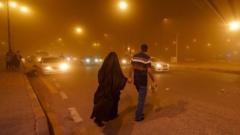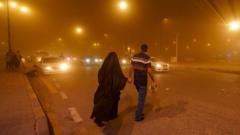A massive sandstorm has engulfed central and southern Iraq over the past two days, transforming the sky into an eerie orange hue and leading to severe visibility issues. Thousands of residents flooded hospitals with respiratory ailments as two major airports halted operations due to the hazardous weather. The relentless winds that swept through cities like Basra diminished transportation to a standstill, highlighting the escalating impact of climate conditions in the region.
**Iraq's Sky Turns Orange as Severe Sandstorm Leads to Health Crisis**

**Iraq's Sky Turns Orange as Severe Sandstorm Leads to Health Crisis**
A powerful sandstorm wreaked havoc in Iraq, triggering respiratory emergencies and grounding flights. Climate experts warn this could be a sign of worsening conditions due to climate change.
Iraq’s meteorology spokesperson, Amir al-Jabri, revealed that the storm originated from eastern Saudi Arabia, gathering sand and dust from arid regions as it journeyed across the border. While sandstorms are a historical phenomenon during Iraq’s winter and early spring, climate specialists report that the frequency and intensity of these storms are escalating, caused by prolonged droughts and desertification affecting large areas of Iraq and Syria.
This sandstorm stands as the most severe so far in 2025; in December, Baghdad was similarly crippled by another intense storm. The United Nations ranks Iraq as one of the top five countries most threatened by climate change, citing extreme temperatures and a sharp decline in water supplies.
As the storm began to subside, southern Iraq still endured soaring temperatures above 100 degrees Fahrenheit prior to the event obscuring sunlight and providing slight relief. During the storm, many residents, including emergency personnel, shielded themselves with face masks or cloths to guard against the storm's severe dust assault.
According to health ministry spokesperson Saif al-Badr, hospitals across the southern region reported nearly 3,750 cases of respiratory distress, including over 1,000 in Basra alone. Most affected areas were near the Saudi Arabian border, with the majority of patients subsequently released after treatment. Local authorities even issued guidelines for families to help children cope with the frightening sounds of the storm.
As Iraq grapples with escalating climate challenges, the severity of this recent sandstorm serves as a stark reminder of the urgent need for solutions to address climate change’s growing impact on public health and safety.
This sandstorm stands as the most severe so far in 2025; in December, Baghdad was similarly crippled by another intense storm. The United Nations ranks Iraq as one of the top five countries most threatened by climate change, citing extreme temperatures and a sharp decline in water supplies.
As the storm began to subside, southern Iraq still endured soaring temperatures above 100 degrees Fahrenheit prior to the event obscuring sunlight and providing slight relief. During the storm, many residents, including emergency personnel, shielded themselves with face masks or cloths to guard against the storm's severe dust assault.
According to health ministry spokesperson Saif al-Badr, hospitals across the southern region reported nearly 3,750 cases of respiratory distress, including over 1,000 in Basra alone. Most affected areas were near the Saudi Arabian border, with the majority of patients subsequently released after treatment. Local authorities even issued guidelines for families to help children cope with the frightening sounds of the storm.
As Iraq grapples with escalating climate challenges, the severity of this recent sandstorm serves as a stark reminder of the urgent need for solutions to address climate change’s growing impact on public health and safety.




















